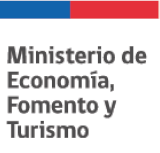
The University of Valparaíso, in conjunction with the Chilean Society of Marine Sciences, organized the 44th Congress of Marine Sciences, which took place from May 26 to 30, 2025, at the Enjoy Hotel in Viña del Mar.
This prominent scientific meeting brought together experts, researchers, and professionals from the marine field, focusing on current and future challenges related to sustainability, technological innovation, and the responsible management of marine ecosystems.
Representing the Direct Evaluations Department of the Fisheries Development Institute were Luis La Cruz, Cristián Henríquez-Pastene, and Francisco Leiva, who presented their research and contributions in various areas of marine sciences.
The conference featured keynote addresses, oral presentations, poster sessions, and opportunities for exchange between science, industry, and civil society, establishing itself as one of the most relevant scientific events in the country in its field.
The conference offered keynote addresses, oral presentations, and poster sessions, as well as opportunities for exchange between science, industry, and civil society, establishing itself as one of the most relevant scientific gatherings in the country in its field.
Summary of their presentations at the conference
Session 1: Fisheries and Fisheries Oceanography
Luis La Cruz*, Javier Legua1, Cristián Henríquez-Pastene1 and Francisco Leiva-Dietz1
1Fisheries Development Institute (IFOP), Valparaíso, Chile
Oral presentation “Comparative Evaluation of Echosounders for Estimating the Anchovy Stock: An Approach from Artisanal and Scientific Vessels in Chilean Coastal Zones”
Read more
In a recent study, we successfully validated the joint use of the scientific vessel Abate Molina and artisanal vessels equipped with high-precision echosounders to assess the anchovy stock in northern and central Chile from 2022 to 2024.
Our acoustic measurements showed high agreement, with differences of less than 3.8% between the two platforms, demonstrating the reliability and accuracy of biomass estimates obtained with different technologies.
This approach strengthens fisheries monitoring by integrating different types of platforms and promotes direct and effective collaboration between science and artisanal fisheries.
Session 2: Fisheries and Fisheries Oceanography
Luis La Cruz (1); Chacón, G (2); Cornejo, R (2); Legua, J (1); & Castillo R (2)
(1) Direct Assessment Department (DED). Fisheries Research Division, Fisheries Development Institute, Valparaíso, Chile
(2) Hydroacoustics Functional Area (AFH). General Directorate of Research in Hydroacoustics, Remote Sensing, and Fishing Gear, Peruvian Marine Institute, Lima, Peru.
Oral presentation: “Identification of adult and juvenile anchovy (Engraulis ringens) schools using broadband acoustics in the Northern Humboldt Current System”
Read more
We observed clear differences in the acoustic response between juveniles and adults, and we were also able to identify other cohabiting species in the ecosystem, such as plankton, munids, salps, and vinciguerrias. This information allows us to better characterize the marine environment and optimize fishery management decisions.
We believe that this technological advancement represents an important step toward more sustainable, selective fishing based on solid scientific evidence.
Session 3: Physical, Chemical, and Geological Oceanography
Cristián Henríquez-Pastene, Javier Legua1, Alejandro Cárdenas2, Jairo Gutierrez1, Adrián Ibieta1, Manuel Rojas1, René Vargas1, Víctor Catasti1, and Jorge Castillo1
1 Department of Direct Assessments, Fisheries Development Institute, Valparaíso, Chile. cristian.henriquez@ifop.cl
2 Department of Sampling Management, Fisheries Development Institute, Aysén, Chile.
Oral presentation “Hydrographic Variability in Northern Chilean Patagonia and its Impact on the Distribution of Small Pelagics, between 2018 and 2024”
Read more
Time-domain analyses identified significant changes in the vertical structure of water masses and the presence of modified Equatorial Subsurface Water. In parallel, spectral analysis revealed spatiotemporal patterns in temperature and salinity that help understand the effect of these variables on the distribution of pelagic species.
The study highlights the importance of integrating multiple sources of information and scales of analysis to understand how environmental variability influences the dynamics of a key ecosystem for national fisheries.




